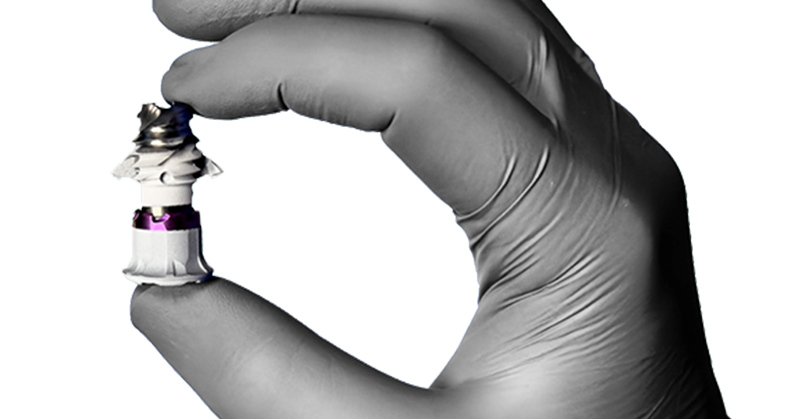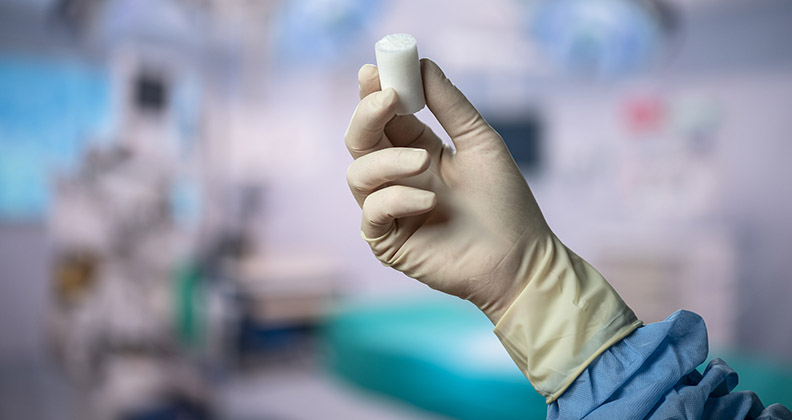
The spine fusion market is experiencing a wave of innovation led by companies focused on developing minimally invasive surgical techniques and modern ways to stabilize vertebrae. It’s a segment with significant growth potential thanks in part to an aging population — the number of people 60 years or older will double between 2020 and 2050 — that is at increased risk of back pain requiring surgery to treat.
A great deal of activity is occurring in the sacroiliac (SI) joint fusion space. “There are more than 40 companies with a lateral SI implant, so we had to bring an innovative solution to the market,” said Parker Snedden, Senior Director of Marketing at Spinal Simplicity. “You need to be unique to win.”
Spinal Simplicity’s Liberty SI Fusion System is designed to treat SI joint disruptions and degenerative sacroiliitis. The procedure involves the lateral insertion of one to two titanium implants transfixed across the ilium and sacrum that are designed to apply a compressive force to stabilize and fuse the SI joint. The platform is single-use and delivered operation-ready to surgeons.
Snedden said Liberty SI stands out in a crowded and competitive market because it was designed based on AO principles, is cleared as a single lateral implant and features wing anchors that deploy inside cancellous bone along the sacral cortical wall to achieve and maintain joint compression. “The wings function as anchors that effectively stabilize the area when compression is achieved,” he explained. “Long-term stabilization is essential when operating on the SI joint.”
In May, Spinal Simplicity received FDA 510(k) clearance to market the Patriot SI Posterior Implant System, which is designed for use with Liberty SI. The clearance introduced a hybrid joint fusion construct, offering new treatment options for conditions such as SI disruptions and degenerative sacroiliitis. The hybrid clearance for Patriot SI allows for precise entry into the joint and facilitates direct access and effective decortication, which can be easily confirmed. The device is threaded, additively manufactured and features a porous architecture that promotes rapid bone growth and fusion.
“The hybrid construct achieves decortication across all planes of the joint,” Snedden explained. “Early testing indicates that the two devices reduce the range of motion in the joint during flexion and extension compared to the use of two lateral screws.”
Patriot SI’s cannulation enhances the reproducibility of the procedure, according to Adam Rogers, Vice President of Regulatory and Engineering at Spinal Simplicity. He noted that it can be difficult to precisely position other inline implants within the SI joint.
“However, with the cannulated Patriot implant, you can insert the guide wire directly into the joint, ensuring it’s placed accurately,” he said. “The guide wire remains in the joint throughout the procedure, confirming that the implant is positioned correctly every time. This feature is expected to greatly improve the consistency of the surgery.”
Spinal Simplicity is focused on developing solutions that promote arthrodesis of the spine and SI joint. The company drew on its experience in the successful designing of the Minuteman fusion implant — which stabilizes and fuses the thoracic, lumbar and sacral spine — and applied those principles to the development of the Liberty and Patriot systems.
Combining the Patriot with the Liberty device allows for active compression of the joint. This means surgeons can decorticate the space, implant the device with graft material and stabilize the area by compressing the joint.
“We believe this hybrid approach will lead to exceptional fusion outcomes, providing the best of both worlds,” Rogers said.
Tried and True Support
The leadership team at SAIL Fusion sees good times ahead for the SI fusion space. “Estimates place the annual market at around $200 million with a projected 15% CAGR,” said Andrew Shepherd, Vice President of Marketing & Clinical Affairs. “We are seeing tremendous demand from surgeons that confirms this growth potential.”
He credits the robust projected growth to a rapidly increasing recognition of the SI joint as a potential pain generator for patients and believes that, until recently, the joint has been largely overlooked as a source of lower back and leg discomfort.
SAIL Fusion’s BowTie SI Fusion System, which was engineered following AO principles and introduced to the U.S. market in June, was designed to maximize the rigidity of the fused SI joint by resisting motion in all planes. The implant’s bowtie shape — also known as a double dovetail — has been used in woodworking for centuries to rigidly join two structures.
The SI joint experiences translation and bending in all directions, so SAIL Fusion incorporated proven biomechanical methods of fixation, such as anti-glide buttressing and diverging fixed-angle screws, to prevent this multiplanar motion. “The implant’s eponymous shape leverages one of history’s strongest methods to reliably hold two objects together,” Shepherd said.
According to Shepherd, BowTie promotes true arthrodesis. “The device and its surgical technique minimize tissue disruption, thoroughly decorticate the joint and provide rigid fixation,” he explained. “It integrates intra-articular and transfixing components, which provide tremendous biomechanical advantages.”
SAIL Fusion conducted market research that included interviews with more than 120 spine surgeons, 80% of whom expressed dissatisfaction with existing lateral SI systems. The surgeons said that conventional devices involve higher risk trajectories, exhibit inadequate implant anchorage in poor-quality bone and have been shown to have a 15% to 20% complication rate. As a result, SAIL Fusion said 60% of the surgeons have avoided performing SI fusion procedures until better solutions became available.
“Not only were the majority of surgeons dissatisfied with existing implants, but they also overwhelmingly emphasized the need for a safer surgical technique that reliably achieves a true and robust fusion of the SI joint,” Shepherd said.
The surgeons also noted that most current technologies utilize a lateral approach without joint decortication that is more suited for stabilization rather than biologic fusion. BowTie creates less tissue disruption, completely avoids major neurovascular structures, better prepares the joint by more thoroughly decorticating the auricular synovial surfaces and provides superior rigid fixation, according to SAIL Fusion.
Shepherd said the company chose to make BowTie out of titanium due to its compatibility with gamma sterilization, which he said is the simplest method to deliver pre-sterilized implants. “Titanium also allows for the creation of porous structures and roughened surface topographies that enable osseointegration and that have been proven to optimize the bone growth response,” he said.
He also noted that titanium supports robust fusion of the SI joint due to its ability to encourage bone growth and its strength profile that resists the tremendous forces that are transferred through the pelvis.
“The pelvis is highly variable, with a 30% to 40% rate of sacral dysmorphism,” Shepherd said. “Because of this factor, we validated the design of the BowTie device to adapt to a wide variety of anatomies using a small number of implants.”
Jeff Kleiner, M.D., Founder and CEO of Kleiner Device Labs (KDL), said systems that implement a combination of posterior debridement of the SI joint to maximize fusion surface area and lateral instrumentation to neutralize the joint shear forces offer the best opportunity for fusion success.

Dr. Anders Cohen performed the first spinal fusion procedure with the new Kleiner Device Labs KG(tm)2 Surge(tm) Flow-Thru Interbody System at the Brooklyn Hospital Center.
Streamlined Approach
The lumbar spine fusion space is brimming with a steady flow of new implants and grafting technologies that are designed to reduce complication risks resulting from poor or insufficient graft volume and placement. That’s why Dr. Kleiner makes sure his customers know that KDL’s KG 2 Surge flow-thru interbody implant system isn’t just a “new, shiny object” and that it’s predicated on maximizing the delivery of the graft material.
KG 2 Surge is a single-use bone graft delivery tool paired with a 3D-printed titanium I-Beam fusion implant. The implant has no lateral walls and allows for the flow of bone graft material through a rectangular insertion tool, which maximizes the cross-sectional area available for graft material flow and eliminates the challenge of trying to apply bone graft after cage insertion.
The patented system comes pre-assembled and sterilized in a single-use tray, making it well-suited for efficient and streamlined surgical workflows. It allows for a single insertion process, a departure from the multi-step, multi-instrument routines that are typical of traditional spine fusion procedures.
Dr. Kleiner practiced as a spine surgeon and grew increasingly frustrated with the available devices that were designed to deliver graft within spinal discs. In response, he founded KDL and began developing unique interbody implants and instruments engineered to improve spine surgery outcomes for patients, surgeons and surgical facilities.
“We set out to create ways for surgeons to maximize bone graft delivery and solve many of the most frustrating parts of fusion procedures that negatively impact outcomes,” Dr. Kleiner said. “The posterior approach has several inherent risks that prevent successful outcomes, as well as significant frustrations for surgeons, and those became the key objectives of our re-engineering a complete interbody system.”
“Instead of designing the implant with a lot of machinery inside that allows it to expand, ours is built to maximize the delivery of any type of graft material into the disc space,” Dr. Kleiner said. “And it does so in a unique fashion.”
He explained that the implant’s I-beam construct is attached to a rectangular cannula that doubles as an inserter. The large posterior channel allows graft material to enter the implant, which has no pinch points with the attached rectangular cannula.
“It permits a whole spectrum of different types of graft materials to go through the implant and into the prepared area of the disc space, and it allows it to be done in a single sequential step,” Dr. Kleiner said. “Surgeons insert the implant and cannula, and then flow graft material through the cannula while the disc space is in its distracted position.”
The implant serves as both a cage and a conduit for graft delivery, Dr. Kleiner pointed out.
The first 50 cases that were performed with KG 2 Surge showed that it took surgeons an average of eight minutes to trial, implant, graft and release the lumbar interbody device in order to deliver an average of 10ml of graft material.
According to Dr. Kleiner, KG 2 Surge saves four steps and about 20 minutes per implantation level during surgery. He believes the device is a much safer spinal fusion option because the implant is never touched during surgery and it prevents the need for surgeons to perform multiple surgical passes. “The system has a much higher success rate in terms of achieving arthrodesis and avoiding complications,” he said.
That’s the ultimate goal of the numerous products that compete for a share of the spine fusion market. Companies that develop effective ways to achieve excellent outcomes with surgeon-pleasing solutions will capitalize on revenue opportunities that are ripe for the taking.
PM
Patrick McGuire is a BONEZONE Contributor.




